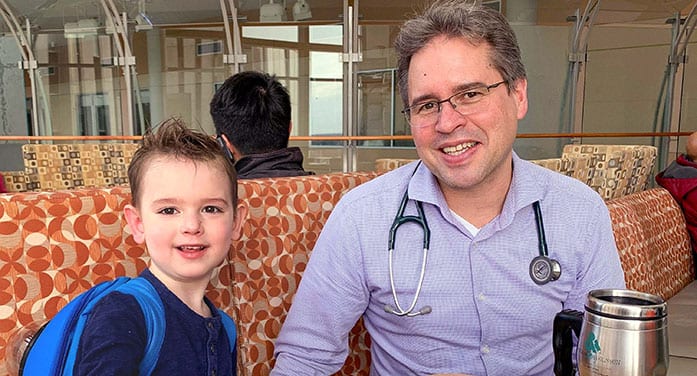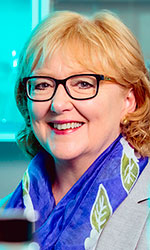A pediatric heart transplant procedure pioneered by Canadian doctors – once deemed impossible – has been shown to be at least as effective as the traditional approach, according to newly published research in The Lancet Child & Adolescent Health.
ABO-incompatible heart transplantation was developed in the mid-1990s, after a Canadian transplant team led by Lori West realized that infants under the age of two have immature immune systems that would allow them to accept life-saving replacements for their defective hearts from donors with incompatible blood types.
“It’s really important to see it has not only helped these very sick babies to get transplants faster, but also to live as long, with no more rejections, and better outcomes with regards to infections, as children who received a matched blood group heart,” said principal investigator Simon Urschel, associate professor of pediatrics in the University of Alberta’s Faculty of Medicine & Dentistry, director of pediatric cardiac transplantation at the Stollery Children’s Hospital and member of the Women and Children’s Health Research Institute (WCHRI).

U of A researcher Simon Urschel with patient George Kemp, who received a heart transplant as a baby and is now four years old. (Photo: Lindsey Kemp)
ABO-incompatible heart transplantation is now routinely carried out in Canada and some other countries, but not everywhere. That should change thanks to these new study results, Urschel said.
“For example, Eurotransplant (the agency responsible for transplants in eight European countries) still considers it an inferior option to be used with caution,” he said. “That concern will probably be relieved in those last places that were reluctant to do it, now that we have shown it is safe.”
About 50 per cent of the population is born with type O blood, while 35 per cent has A type and 15 per cent has B or AB type blood. Organs from a donor with type O blood can be accepted by anyone, but adult type O patients can receive only type O organs. The development of ABO-incompatible pediatric heart transplantation meant that twice as many organs would be available to type O infants born with heart defects.
Urschel and his team analyzed data from more than 2,200 infant transplant recipients in Canada, the United Kingdom and the United States from 1999 to 2018. The records were from the Pediatric Heart Transplant Society registry, an international research collaboration that collects data from 58 transplant centres. This resulted in more than 11,000 cumulative patient-years of observation, by far the largest study of its kind.
Three hundred sixty-four of the babies received ABO-incompatible transplants, while 1,842 received ABO-compatible hearts. “We wanted to compare apples with apples, so the children were matched by characteristics such as their underlying disease and the age at which they underwent surgery,” Urschel said.
The researchers found the survival rate was the same between the two groups, as were the rates of acute and chronic organ rejection and the risk of developing leukemia after transplant. They also examined the rates of post-transplant bacterial, viral and fungal infections, which they were concerned might be higher among the ABO-incompatible transplant recipients.
“Interestingly, we found that there were fewer of the infections that we were worried about in the ABO-incompatible patients,” Urschel said.
Earlier work by Urschel’s research team showed that wait times for these patients were significantly shortened, with the average time to transplant being about 50 per cent shorter thanks to the innovative transplant technique.
“It’s easier and faster to find a heart for these patients, which is crucial because they are extremely sick, often on mechanical heart support devices or on ventilators in intensive care units,” he said. “This gives them a chance not only to survive but to stay healthier and be in better condition before and after transplantation.”
The pioneering pediatric heart surgeons who started it all in 1996 – West and Ivan Rebeyka – refined their method after being recruited to join the U of A faculty, with help from other faculty members such as Urschel. Urschel and West’s work has received funding from the Stollery Children’s Hospital Foundation through WCHRI.
The ‘rule’ requiring ABO-compatible donors was instituted for older patients and had never been revisited from the perspective of the immunologic immaturity of infants, said West, now Canada Research Chair (Tier 1) in Cardiac Transplantation, and director of the Alberta Transplant Institute and the Canadian Donation and Transplantation Research Program.
“This, in combination with an extremely high mortality for infants on our transplant waiting list, is why we instituted the first ABO-incompatible transplant protocol,” she said.
“Transplantation has always been about pushing the boundaries of risks in order to offer reasonable options to patients who would otherwise have no options.”
Urschel will continue his work to understand the mechanism in infant immune systems that allows them to accept blood type-incompatible hearts, in hopes of being able to one day use what’s learned to help older transplant recipients. He’s also involved in projects to improve the quality of life of young transplant patients and their families.
“It’s a real lesson in the need for scientific vigour to guide our operationalization of clinical protocols, not just the blind adoption of previously accepted regulations,” said West.
The fact that heart transplant recipients can now survive with a normal lifespan is a credit to both West and Rebeyka, who has a clinical faculty position with the U of A’s Cardiovascular Research Centre, said Urschel, who continues to provide clinical care for teenage and young adult patients who received ABO-incompatible transplants as babies.
“It’s just amazing to see them, knowing that at one time they were so sick in the intensive care unit that they might not make it to the next day,” Urschel said.
| By Gillian Rutherford for Troy Media
This article was submitted by the University of Alberta’s Folio online magazine. Folio is a Troy Media![]() Editorial Content Provider Partner.
Editorial Content Provider Partner.
The views, opinions and positions expressed by columnists and contributors are the authors’ alone. They do not inherently or expressly reflect the views, opinions and/or positions of our publication.



